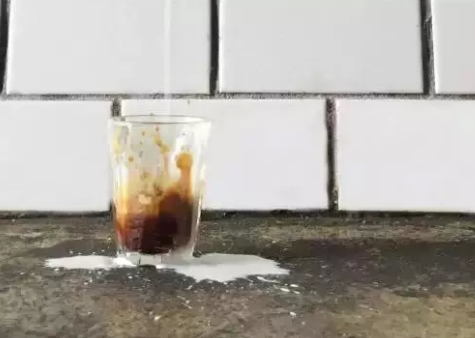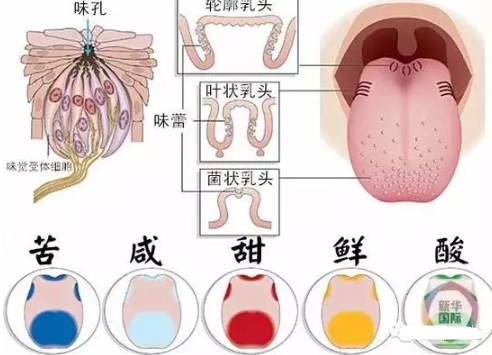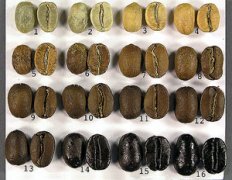A brief talk on the Story of Milk Coffee and Milk

Before combing the conclusion, the spectators who need to come in should first understand the following three concepts.
Emulsification-this is an old concept used in espresso, but only one emulsification result is given. In fact, oil and some fat-soluble, non-water-soluble substances are extracted under high pressure and used as surface agents by proteins and other strange things in coffee, causing these lipids to be suspended in coffee liquid and mixed with gases to form CREMA.
Surfactants, or surfactants, only need to understand that they can mix two immiscible liquids. For example, water and oil are stratified normally, and when surface agents are added, they will become a mixture of oil and water. Milk is a natural application product of surface agents. Milk fat is wrapped in casein calcium salt and suspended in the milk liquid to form an emulsion.
"fat" taste-in addition to sour, sweet, bitter, salty and fresh, the confirmed sixth basic flavor can be partially expressed as greasy, oily and irritating, reminiscent of pork belly, fried steak, safflower seed oil, fat grains and so on.

Beside the point.
Espresso in the conventional extraction process (non-variable pressure or so-called converter), in fact, the pressure in the handle is gradually increased, until the powder is fully absorbed and expanded, you can know after using Shot Brewer, most semi-automatic coffee machines, including controllable pressure, even if the value of the pressure gauge is constant, the pressure in the handle is not as shown in the pressure gauge.
No matter how the pressure changes, the extraction of lipids and proteins in espresso is undeniable, and the proteins also play the role of surface agents, not only the formation of CREMA mentioned above, but also a state similar to emulsion in the liquid, as well as free fat.
Then, in the process of milk, due to the change of temperature and movement, the physical denaturation of the protein solution occurs (the solution containing protein is the protein solution. All animal milk, plant milk, all kinds of eggs, etc.), this kind of degeneration is irreversible, for example, eggs cannot be boiled into egg flowers, milk bubbles cannot be reduced to the original milk, and the casein structure destroyed by milk heating releases fat, even if it is cooled down, these fats can not go back to the embrace of protein, and there will be a "milk skin" after static placement.
In the process of denaturation, protein structure is destroyed, gas enters, and free fat, which is free from protein entanglement, and protein (surface agent) are mixed to form milk foam.
The higher the proportion of milk foam, the more fat is consumed. After blending with coffee, the free fat in the liquid is less, and the taste of "fat" is less obvious. I suddenly found that although the translation of "fat white" (Flat White) is earthy, it is quite appropriate. Because the proportion of Australian white milk foam is low, free fat is more likely to be more than latte and Cabo, so it is easier to show "fat" in taste, while Cabo is more likely to show sweetness. To some extent, it is also because the fat taste is less, so the milk ingredient in another "giant"-lactose is more recognizable.
Then some people must question why they do not add milk directly and have to get rid of it. It has been stated in the first two paragraphs that without heating or exercise, there will be no denaturation and free fat will not be released, and the "fat" flavor will not be easy to appear.
For more practical applications, when choosing milk, milk fat is indeed an important indicator that affects taste and taste, while the protein ratio is related to the quality of milk and the extent to which topical agents can affect it when mixed with Espresso, which is why baristas come across buying multiple brands of milk with the same proportion of cream, but some get blisters soon after they are finished. The rhetoric of the old days and most of the current training courses only describe the effect of fat ratio, but ignore the central role of surfactants (proteins) in the formation of milk foam.
As for whether the protein in milk will have a surfactant effect on the lipids in Espresso, Xiao'ao has not yet found the relevant accurate discussion. I also hope that this article will lead to invisible guidance.

This article refers to: "Scientific Squirrel Club", "Coffee flower drawing and surface agent", "surface agent", "emulsification", "protein solution", "milk composition", "milk fat percentage", "fat flavor".
Combing and deducing is Xiao'ao 's own opinion, half-way monk's personal understanding, and the exposition of related concepts has also been proofread and simplified by Xiao'ao. If there are any mistakes and omissions, the above information and relevant authors are not responsible.
In addition, the personal intellectual property rights lost in the article are reproduced and applied in practice, bearing in mind professional ethics and the spirit of sharing.
Important Notice :
前街咖啡 FrontStreet Coffee has moved to new addredd:
FrontStreet Coffee Address: 315,Donghua East Road,GuangZhou
Tel:020 38364473
- Prev

The picture and text of roasting coffee beans shows that there are different degrees of changes from raw beans to roasting.
Naked eye observation as one of the methods to determine the roasting degree of coffee beans is very limited when used alone. If it is supplemented by the judgment of burst sound and the discrimination of fragrance, quite accurate results can be obtained. But the world of coffee is full of surprises and rarely conventional, and explosive Sumatra is often mistaken for urban baking. On the other hand, the color of some coffee beans after roasting will look better than that of actual roasting.
- Next

The Best interpretation of Coffee and Life
One person with one heart and one cup in hand, indulge in the notes, accumulate in the depression, taste the mood coffee in the antique, float the coffee mood, perceive the true feelings, touch the memories. The strong taste of coffee, bitter and sweet, sour and astringent, scattered and endless fragrance also submerged the whole environment, drowning all the vicissitudes and maturity, troubles and thoughts, difficulties and worries, deep reflection
Related
- Beginners will see the "Coffee pull flower" guide!
- What is the difference between ice blog purified milk and ordinary milk coffee?
- Why is the Philippines the largest producer of crops in Liberia?
- For coffee extraction, should the fine powder be retained?
- How does extracted espresso fill pressed powder? How much strength does it take to press the powder?
- How to make jasmine cold extract coffee? Is the jasmine + latte good?
- Will this little toy really make the coffee taste better? How does Lily Drip affect coffee extraction?
- Will the action of slapping the filter cup also affect coffee extraction?
- What's the difference between powder-to-water ratio and powder-to-liquid ratio?
- What is the Ethiopian local species? What does it have to do with Heirloom native species?

